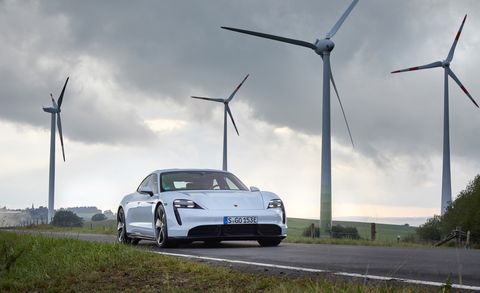- Making a later update to a car from a previous model year may be unusual, but Porsche has done it, offering a replacement for the factory-installed onboard charger to a more powerful one.
- The newer 19.2-kW AC charging unit will let owners of the 2020 Taycan charge their vehicle several hours faster.
- Owners of newer Taycans can get the upgrade as well, but the real benefit is to 2020 models that will become as up-to-date as new models when it comes to charging speed.
Software updates to add new or uprated features to electric cars are no longer a new and novel idea. Tesla’s been doing them for a decade; its first over-the-air update for the Model S was in October 2012. Other makers have followed, with software reflashes done at dealerships (which predated Tesla, but were almost always for safety recalls) and now, increasingly, over the air.
But updating hardware—actual physical components of the car—is a different and far rarer offer. So a recent announcement by Porsche is an admirable outlier: The company will offer owners of 2020 Taycan electric sports sedans the ability to replace the 9.6-kilowatt onboard AC charger fitted at the factory with a more powerful 19.2-kW unit, launched in 2021 as a $1680 option. The upgrade can shave several hours off an overnight recharge.
Owners of 2021 and later models who want faster AC charging benefit as well: The upgrade is offered for any Taycan. But it’s particularly important for the first-year models, bringing them up to the same charging ability as the highest-spec Taycans sold new in dealerships today.
The 19.2-kW charger lets the car charge faster on a Level 2 (240-volt) AC garage charging station, if that station can deliver the higher power and is wired on a circuit that can supply it. The difference in charge times is substantial: the Taycan’s 71.0-kilowatt-hour Performance Battery can recharge from zero to 100 percent in 4.8 hours, against 9.5 hours using the original charger. For more powerful Taycans with the 83.7-kWh Performance Battery Plus, the same charge will take 5.3 hours versus a previous 10.5 hours.
The replacement isn’t a minor operation, since the charger is located behind the front trunk and requires a new section of wiring harness. The full parts kit (number 9J1.044.900.31) carries a retail price of $1850.15. Porsche estimates 12 hours of labor will be required for the full retrofit. At dealership rates that can reach $200 per hour or more, the total tab for charging twice as fast could run owners $4500 or so.
Bonus: Plug & Charge
There’s an additional benefit, though. The software upgrade for the new onboard charger also gives 2020 Taycan owners a new and desirable capability: the Plug & Charge protocol that lets them plug into an Electrify America DC fast-charging station and then walk away, with all verification and billing handled on the back end. Just like a Tesla using the company’s Supercharger fast-charging network, in fact. (Note that the upgraded AC charger has nothing to do with DC fast charging via Electrify America; the Plug & Charge ability comes as a bonus in the software upgrade that allows the new charger to work.)
But why is the new charger such a unicorn? Essentially because hardware updates are extremely uncommon among carmakers. The car that rolls out the factory door is the one that a final owner will drive a decade or more later. Any changes to the factory spec are almost certainly due to safety recalls, and these days they’re far more likely to be tweaks to the car’s powertrain control or software for advanced driver-assistance systems than they are hardware.
Software Is Easy; Hardware Isn’t
There are some notable exceptions. In October 2009, Toyota began a recall that included sawing off a portion of the accelerator pedals on 3.8 million vehicles to avert floor-mat fouling after the questionable “sudden acceleration” concern. In general, though, makers change vehicle hardware only with great reluctance—and almost never design vehicles to allow hardware upgrades.
Anecdote 1: Many vehicles early in the past decade that were fitted with GM’s Onstar communications feature accessed it via 3G cellular service. (Yes, Virginia, there was once such a thing.) This month, cellular carriers will finally shut down that network. Has GM offered a retrofit to allow owners of the 2015 and earlier cars to use newer cellular networks? Nope. A Change.org petition to demand that hasn’t even made its goal of 2500 names.
Anecdote 2: In 2015, Ford unveiled Sync 3, an entirely new version of its connectivity software that superseded the much reviled MyFordTouch system, which had subpar (to be kind) voice recognition. At a launch event, I asked the Ford exec in charge, “So the Fusion sedan with Sync 3 looks just like the one with MyFordTouch you sold until a few weeks ago. If I had bought one of those, how would I upgrade to the new feature?”
He looked at me blankly. Finally, the answer emerged: “The upgrade path is the purchase of a new vehicle.” And he walked away.
Porsche hasn’t commented on whether the Taycan was designed to permit replacement of the onboard charger from the start. But it’s worth underscoring how rare this capability is—and highlighting it as an example for other makers. Whether they’d be willing to spend time and effort to allow owners to upgrade vehicles they’ve already sold, of course, remains an open question.
This content is imported from OpenWeb. You may be able to find the same content in another format, or you may be able to find more information, at their web site.


